4.1.3: Angles on the Coordinate Plane
( \newcommand{\kernel}{\mathrm{null}\,}\)
Learning Objectives
- Draw angles in standard position.
- Convert between degrees and radians.
- Find coterminal angles.
- Find the length of a circular arc.
- Use linear and angular speed to describe motion on a circular path.
Before you get started, take this readiness quiz.
- Find an integer
- Draw an angle measuring
- Reduce
An angle is formed from the union of two rays, by keeping the initial side fixed and rotating the terminal side. The amount of rotation determines the measure of the angle. An angle is in standard position if its vertex is at the origin and its initial side lies along the positive
Angles that are larger than
Drawing Angles in Standard Position
To formalize our work, we will begin by drawing angles on an
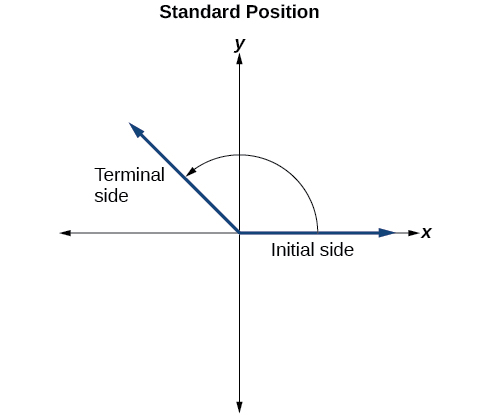
If the angle is measured in a counterclockwise direction from the initial side to the terminal side, the angle is said to be a positive angle. If the angle is measured in a clockwise direction, the angle is said to be a negative angle.
Drawing an angle in standard position always starts the same way—draw the initial side along the positive
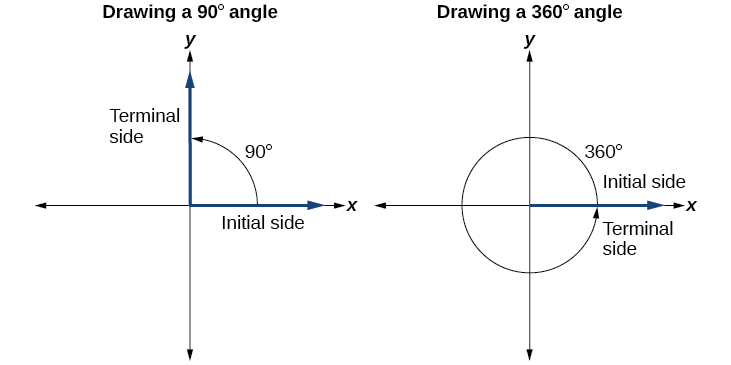
Given an angle measure in degrees, draw the angle in standard position
- Express the angle measure as a fraction of 360°.
- Reduce the fraction to simplest form.
- Draw an angle that contains that same fraction of the circle, beginning on the positive
Example
1. Sketch an angle of 30° in standard position.
2. Sketch an angle of −135° in standard position.
Solution
1. Divide the angle measure by 360°.
To rewrite the fraction in a more familiar fraction, we can recognize that
One-twelfth equals one-third of a quarter, so by dividing a quarter rotation into thirds, we can sketch a line at 30° as in Figure
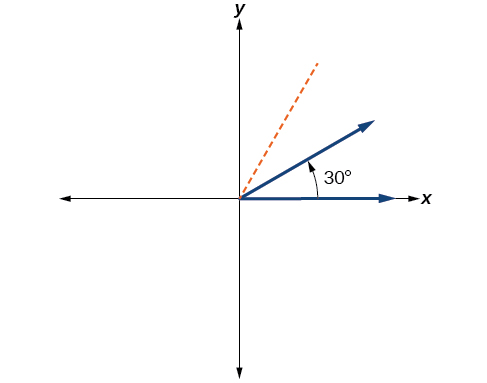
Figure
2. Divide the angle measure by 360°.
In this case, we can recognize that
Negative three-eighths is one and one-half times a quarter, so we place a line by moving clockwise one full quarter and one-half of another quarter, as in Figure
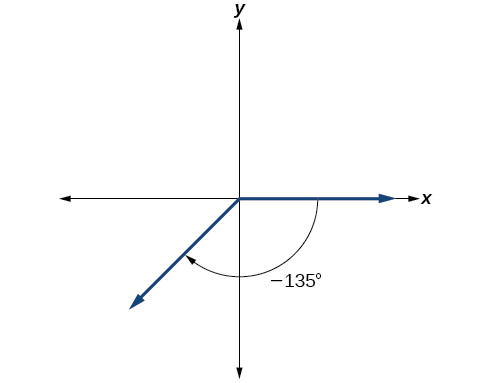
Figure
Show an angle of 240° on a circle in standard position.
- Answer
-
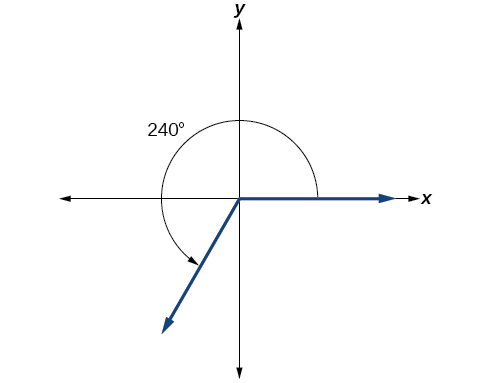
Figure
Converting Between Degrees and Radians
Dividing a circle into 360 parts is an arbitrary choice, although it creates the familiar degree measurement. We may choose other ways to divide a circle. To find another unit, think of the process of drawing a circle. Imagine that you stop before the circle is completed. The portion that you drew is referred to as an arc. An arc may be a portion of a full circle, a full circle, or more than a full circle, represented by more than one full rotation. The length of the arc around an entire circle is called the circumference of that circle.
The circumference of a circle is
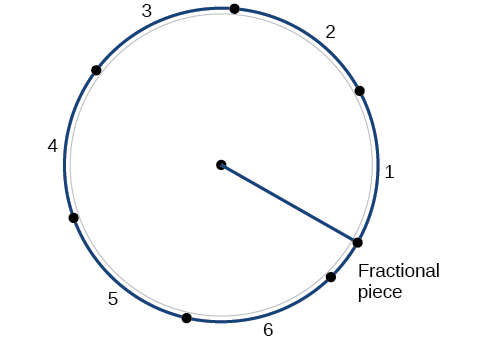
This brings us to our new angle measure. One radian is the measure of a central angle of a circle that intercepts an arc equal in length to the radius of that circle. A central angle is an angle formed at the center of a circle by two radii. Because the total circumference equals
See Figure
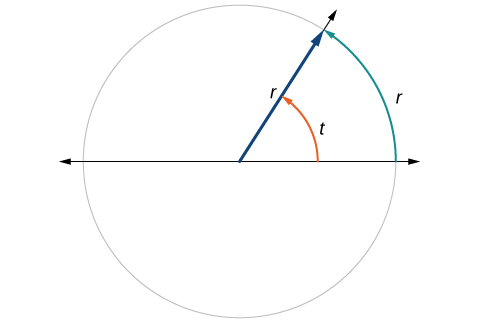
Relating Arc Lengths to Radius
An arc length
This ratio, called the radian measure, is the same regardless of the radius of the circle—it depends only on the angle. This property allows us to define a measure of any angle as the ratio of the arc length s s to the radius
If

To elaborate on this idea, consider two circles, one with radius 2 and the other with radius 3. Recall the circumference of a circle is
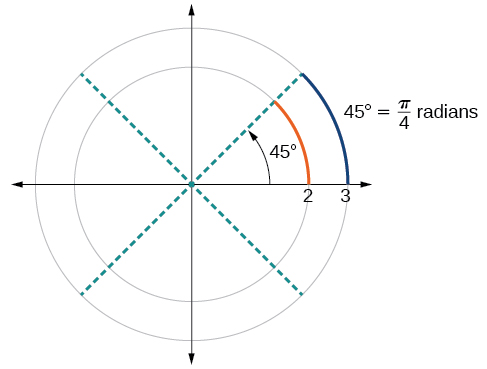
Notice what happens if we find the ratio of the arc length divided by the radius of the circle.
Since both ratios are
RADIANS
One radian is the measure of the central angle of a circle such that the length of the arc between the initial side and the terminal side is equal to the radius of the circle. A full revolution (360°) equals
The radian measure of an angle is the ratio of the length of the arc subtended by the angle to the radius of the circle. In other words, if
A measure of 1 radian looks to be about 60°. Is that correct?
Yes. It is approximately 57.3°. Because
Using Radians
Because radian measure is the ratio of two lengths, it is a unitless measure. For example, in Figure
Considering the most basic case, the unit circle (a circle with radius 1), we know that 1 rotation equals 360 degrees, 360°. We can also track one rotation around a circle by finding the circumference,
Identifying Special Angles Measured in Radians
In addition to knowing the measurements in degrees and radians of a quarter revolution, a half revolution, and a full revolution, there are other frequently encountered angles in one revolution of a circle with which we should be familiar. It is common to encounter multiples of 30, 45, 60, and 90 degrees. These values are shown in Figure
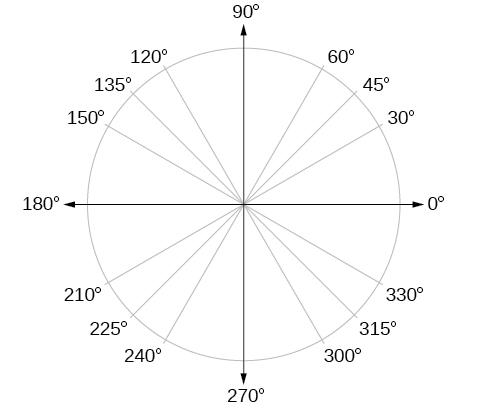
Now, we can list the corresponding radian values for the common measures of a circle corresponding to those listed in Figure
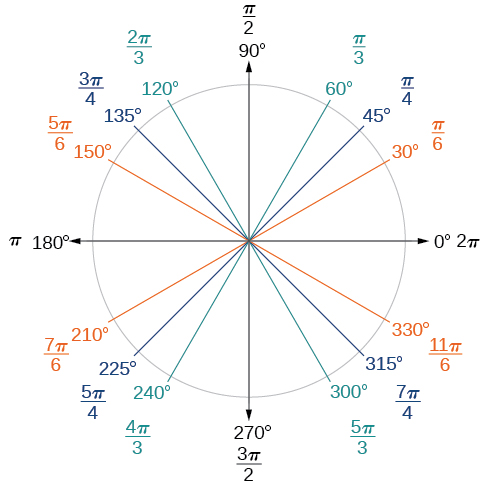
Example
Find the radian measure of one-third of a full rotation.
Solution
For any circle, the arc length along such a rotation would be one-third of the circumference. We know that
So,
The radian measure would be the arc length divided by the radius.
Try It
Find the radian measure of three-fourths of a full rotation.
Solution
Converting between Radians and Degrees
Because degrees and radians both measure angles, we need to be able to convert between them. We can easily do so using a proportion. We will use
This proportion shows that the measure of angle
CONVERTING BETWEEN RADIANS AND DEGREES
To convert between degrees and radians, use the proportion
Example
Convert each radian measure to degrees.
- 3
Solution
Because we are given radians and we want degrees, we should set up a proportion and solve it.
- We use the proportion, substituting the given information.
- We use the proportion, substituting the given information.
Try It
Convert
Solution
−135°
Example
Convert
Solution
In this example, we start with degrees and want radians, so we again set up a proportion and solve it, but we substitute the given information into a different part of the proportion.
Analysis
Another way to think about this problem is by remembering that
Try It
Convert 126° to radians.
Solution
Finding Coterminal Angles
Converting between degrees and radians can make working with angles easier in some applications. For other applications, we may need another type of conversion. Negative angles and angles greater than a full revolution are more awkward to work with than those in the range of
It is possible for more than one angle to have the same terminal side. Look at Figure
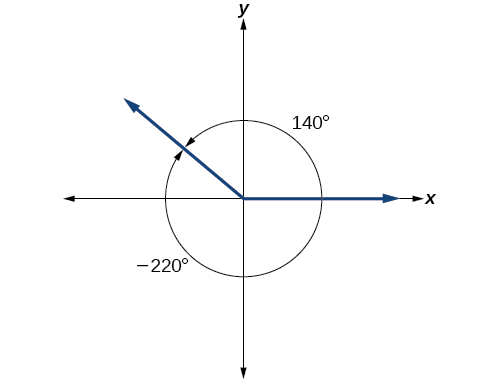
Any angle has infinitely many coterminal angles because each time we add
An angle’s reference angle is the measure of the smallest, positive, acute angle
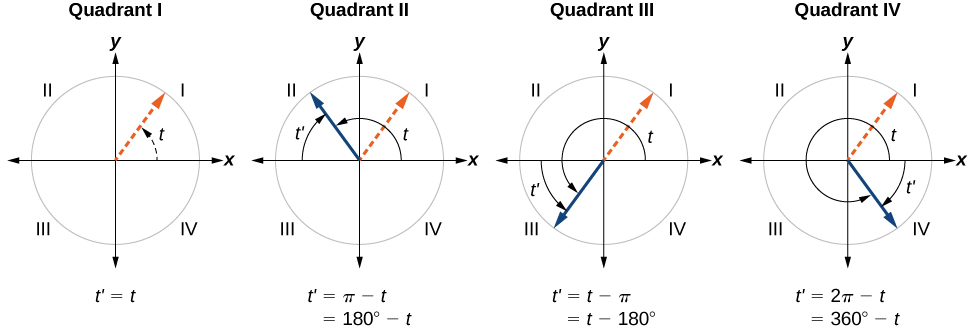
COTERMINAL AND REFERENCE ANGLES
- Coterminal angles are two angles in standard position that have the same terminal side.
- An angle’s reference angle is the size of the smallest acute angle,
Given an angle greater than
- Subtract
- If the result is still greater than
- The resulting angle is coterminal with the original angle.
Example
Find the least positive angle
Solution
An angle with measure
The angle
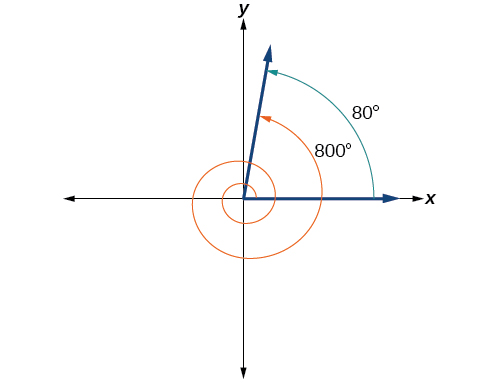
Try It
Find an angle
Solution
Given an angle with measure less than
- Add
- If the result is still less than
- The resulting angle is coterminal with the original angle.
Example
Show the angle with measure
Solution
Since
Because we can find coterminal angles by adding or subtracting a full rotation of
We can then show the angle on a circle, as
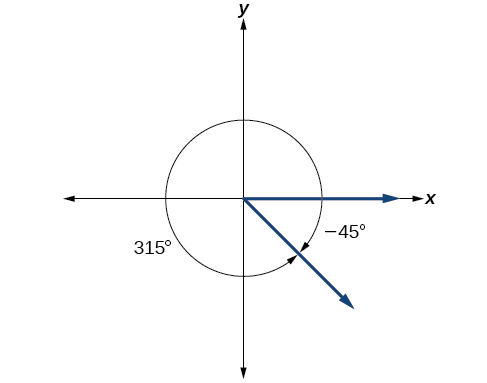
Try It
Find an angle
Solution
Finding Coterminal Angles Measured in Radians
We can find coterminal angles measured in radians in much the same way as we have found them using degrees. In both cases, we find coterminal angles by adding or subtracting one or more full rotations.
Given an angle greater than
- Subtract
- If the result is still greater than
- The resulting angle is coterminal with the original angle.
Example
Find an angle
Solution
When working in degrees, we found coterminal angles by adding or subtracting 360 degrees, a full rotation. Likewise, in radians, we can find coterminal angles by adding or subtracting full rotations of
The angle
The angle
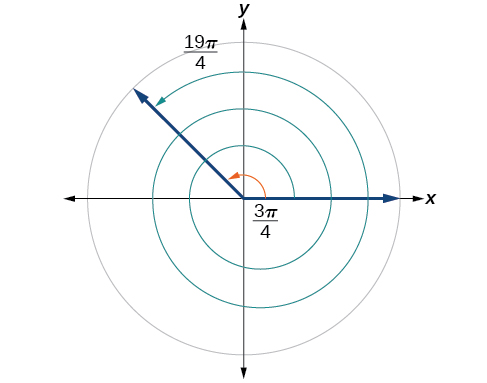
Try It
Find an angle of measure
Solution
Determining the Length of an Arc (optional)
Recall that the radian measure
ARC LENGTH ON A CIRCLE
In a circle of radius r, the length of an arc
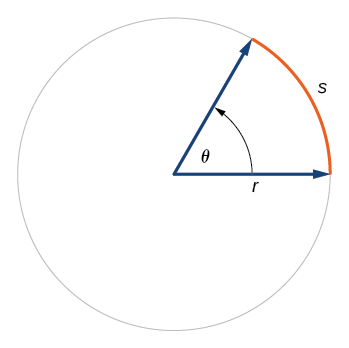
Given a circle of radius
- If necessary, convert
- Multiply the radius
Example
Assume the orbit of Mercury around the sun is a perfect circle. Mercury is approximately 36 million miles from the sun.
- In one Earth day, Mercury completes 0.0114 of its total revolution. How many miles does it travel in one day?
- Use your answer from part (a) to determine the radian measure for Mercury’s movement in one Earth day.
Solution
- Let’s begin by finding the circumference of Mercury’s orbit.
Since Mercury completes 0.0114 of its total revolution in one Earth day, we can now find the distance traveled:
- Now, we convert to radians:
Try It
Find the arc length along a circle of radius 10 units subtended by an angle of 215°.
Solution
Finding the Area of a Sector of a Circle (optional)
In addition to arc length, we can also use angles to find the area of a sector of a circle. A sector is a region of a circle bounded by two radii and the intercepted arc, like a slice of pizza or pie. Recall that the area of a circle with radius
AREA OF A SECTOR
The area of a sector of a circle with radius
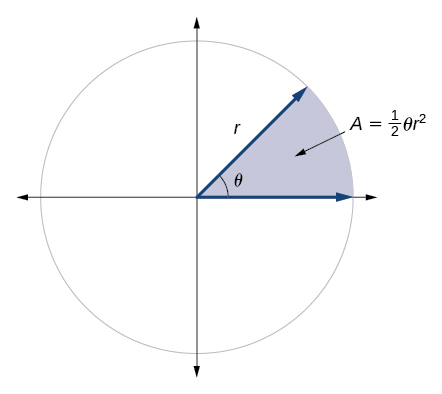
Given a circle of radius
- If necessary, convert
- Multiply half the radian measure of
Example
An automatic lawn sprinkler sprays a distance of 20 feet while rotating 30 degrees, as shown in the figure below. What is the area of the sector of grass the sprinkler waters?
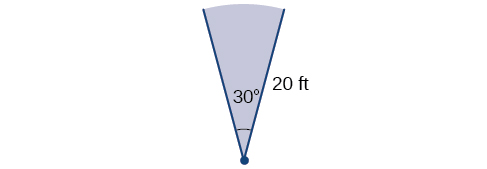
Solution
First, we need to convert the angle measure into radians. Because 30 degrees is one of our special angles, we already know the equivalent radian measure, but we can also convert:
The area of the sector is then
So the area is about
Try It
In central pivot irrigation, a large irrigation pipe on wheels rotates around a center point. A farmer has a central pivot system with a radius of 400 meters. If water restrictions only allow her to water 150 thousand square meters a day, what angle should she set the system to cover? Write the answer in radian measure to two decimal places.
Solution
1.88
Use Linear and Angular Speed to Describe Motion on a Circular Path (optional)
In addition to finding the area of a sector, we can use angles to describe the speed of a moving object. An object traveling in a circular path has two types of speed. Linear speed is speed along a straight path and can be determined by the distance it moves along (its displacement) in a given time interval. For instance, if a wheel with radius 5 inches rotates once a second, a point on the edge of the wheel moves a distance equal to the circumference, or 10\pi inches, every second. So the linear speed of the point is
Angular speed results from circular motion and can be determined by the angle through which a point rotates in a given time interval. In other words, angular speed is angular rotation per unit time. So, for instance, if a gear makes a full rotation every 4 seconds, we can calculate its angular speed as
Combining the definition of angular speed with the arc length equation,
Substituting this into the linear speed equation gives:
ANGULAR AND LINEAR SPEED
As a point moves along a circle of radius
The linear speed.
When the angular speed is measured in radians per unit time, linear speed and angular speed are related by the equation
This equation states that the angular speed in radians,
Given the amount of angle rotation and the time elapsed, calculate the angular speed
- If necessary, convert the angle measure to radians.
- Divide the angle in radians by the number of time units elapsed:
- The resulting speed will be in radians per time unit.
Example
A water wheel, shown in the figure, completes 1 rotation every 5 seconds. Find the angular speed in radians per second.

Solution
The wheel completes 1 rotation, or passes through an angle of
Try It
An old vinyl record is played on a turntable rotating clockwise at a rate of 45 rotations per minute. Find the angular speed in radians per second.
Solution
Given the radius of a circle, an angle of rotation, and a length of elapsed time, determine the linear speed
- Convert the total rotation to radians if necessary.
- Divide the total rotation in radians by the elapsed time to find the angular speed: apply
- Multiply the angular speed by the length of the radius to find the linear speed, expressed in terms of the length unit used for the radius and the time unit used for the elapsed time: apply
Example
A bicycle has wheels 28 inches in diameter. A tachometer determines the wheels are rotating at 180 RPM (revolutions per minute). Find the speed the bicycle is traveling down the road.
Solution
Here, we have an angular speed and need to find the corresponding linear speed, since the linear speed of the outside of the tires is the speed at which the bicycle travels down the road.
We begin by converting from rotations per minute to radians per minute. It can be helpful to utilize the units to make this conversion:
Using the formula from above along with the radius of the wheels, we can find the linear speed:
Remember that radians are a unitless measure, so it is not necessary to include them.unitless measure, so it is not necessary to include them.
Finally, we may wish to convert this linear speed into a more familiar measurement, like miles per hour.
Try It
A satellite is rotating around Earth at 0.25 radians per hour at an altitude of 242 km above Earth. If the radius of Earth is 6378 kilometers, find the linear speed of the satellite in kilometers per hour.
Solution
1655 kilometers per hour
- Give an example of how to convert radians to degrees.
- Describe how to find an angle
- How can you find the angle
Exit Question
1. Convert
2. Find an angle
Key Concepts
- An angle is formed from the union of two rays, by keeping the initial side fixed and rotating the terminal side. The amount of rotation determines the measure of the angle.
- An angle is in standard position if its vertex is at the origin and its initial side lies along the positive x-axis. A positive angle is measured counterclockwise from the initial side and a negative angle is measured clockwise.
- To draw an angle in standard position, draw the initial side along the positive x-axis and then place the terminal side according to the fraction of a full rotation the angle represents.
- In addition to degrees, the measure of an angle can be described in radians.
- To convert between degrees and radians, use the proportion
- Two angles that have the same terminal side are called coterminal angles.
- We can find coterminal angles by adding or subtracting 360° or
- Coterminal angles can be found using radians just as they are for degrees.
- The length of a circular arc is a fraction of the circumference of the entire circle.
- The area of sector is a fraction of the area of the entire circle.
- An object moving in a circular path has both linear and angular speed.
- The angular speed of an object traveling in a circular path is the measure of the angle through which it turns in a unit of time.
- The linear speed of an object traveling along a circular path is the distance it travels in a unit of time.
Contributors and Attributions
Jay Abramson (Arizona State University) with contributing authors. Textbook content produced by OpenStax College is licensed under a Creative Commons Attribution License 4.0 license. Download for free at https://openstax.org/details/books/precalculus.


